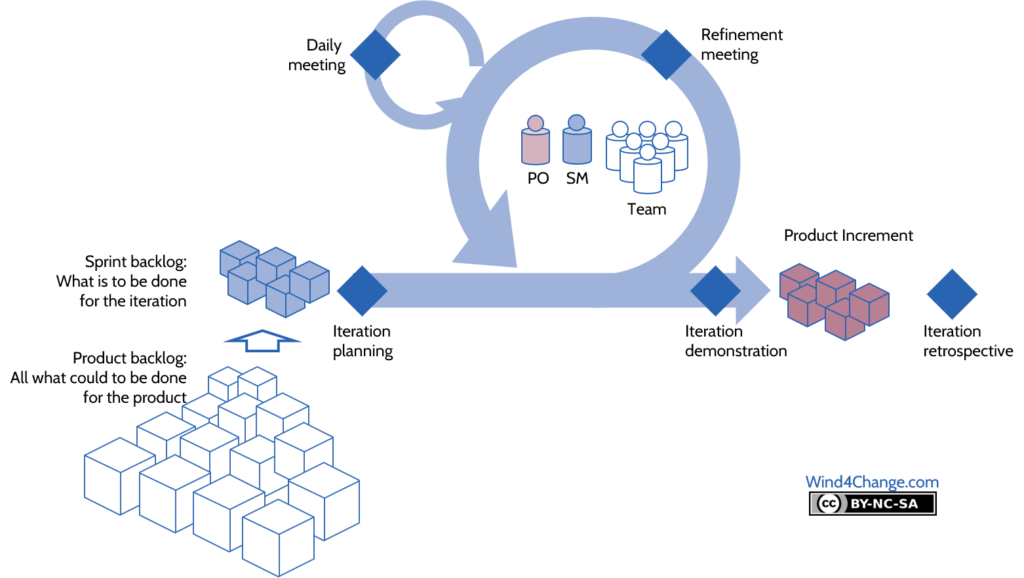What is Scrum? What are the 6 artifacts, the 3 roles, and the 5 ceremonies in Scrum?
- Scrum at a glance
- What are the 6 artifacts in Scrum? 3 mandatory and 3 optional artifacts
- What are the 3 roles in Scrum?
- What are the 5 meetings, also called in Agile ceremonies in Scrum?
- What's next? Learn more about the other main framework to implement Agile: Kanban
- Do you want to learn more about Scrum? Here are some valuable references
Scrum at a glance

What are the 6 artifacts in Scrum? 3 mandatory and 3 optional artifacts
Product backlog
All what could to be done for the product. Indeed, there is a vision but the Product Owner does not identify all the features in detail since the beginning. Some are not identified yet and all may change in order to maximize value to the customers.
Iteration / Sprint backlog
All the features prioritized as the next most valuable features to be build during the iteration / sprint.
Product increment
All the features developed and demonstrated to the client ready to go to production. Roll out to production is not systematic as there may be a need to build other features in order to be able to deliver to production a consistent product increment.
Cockpit: Visual Management, Burn-down and Velocity
- Firstly, visual Management of the sprint progress
- Secondly, burn-down chart on the feature built for the sprint
- Thirdly, follow up of the team velocity sprint after sprint to support continuous improvement
Continuous Improvement action plan
Decisions and actions to improve the way the team works and the collaboration with the Product Owner and Subject Matter Experts.
Definition of Ready and Definition of Done
The team shares explicit criteria to define when a feature is ready to build and when it is completed.
What are the 3 roles in Scrum?
The Product Owner
He/she is the voice of the customers. The PO may rely on Subject Matter Experts to carry the voice of the customers. But he/she must knows enough to enforce prioritization of features and to maximize the value delivered. The PO potentially helped by Subject Matter Experts validates the features.
The Scrum Master
He/she is the guardian of the Scrum framework and enforces the team properly follows it. In addition, the Scrum Master acts as a facilitator of the Scrum meetings, the artifacts and supports with the team the visibility on the progress thanks to indicators and visual management. At last, he/she supports the team removing roadblocks and managing external contributions if any.
The team
An empowered, committed and skilled group software developers, business analysts and testers building the features. Surely, in a perfect world, all team members are multi-skilled and can play all the roles.
What are the 5 meetings, also called in Agile ceremonies in Scrum?
The sprint planning
At the beginning of the sprint, the PO provides the vision of what is expected for the sprint and prioritizes the features to be built. He/she answers the last questions of the team for them to understand what is expected and the purpose of the features. The team then confirm their capacity to deliver prioritized features and commit.
The daily meetings
Daily, the team members meet to make sure they are fully in sync with a short (less than 15 minutes), but useful meeting. Each team member shares last achievements, next steps and blocking issues if any. Of course the team members have by the flow exchanges. But experience is that the daily meeting is a relevant gatekeeper and secures communication even for collocated team members.
The demonstration meeting
At the end of the sprint, the team demonstrates the features built during the sprint to the PO and the Subject Matter Experts. The name of this meeting is important because they do not just show the features. They come back to the PO’s acceptance criteria then demonstrate how each feature meet them. In addition to the validation of the features, this meeting is an opportunity for the team to collect feedback from the PO and the SME and to learn better about the customers and their expectations. PO will also get more mature on the needs when dealing sprint after sprint with the delivered features.
The retrospective meeting
At the end of the sprint after the demonstration, the team with the PO take a step back to identify what went well and is to continue and what is to improve. As a result, this will lead to decisions and actions that may require time to be delivered. So, they will be taken into account in the next sprints within the capacity reserved for continuous improvement.
The refinement meeting
This meeting is not in the Scrum standard framework. This meeting usually conducted mid-sprint is relevant to make backlog get more mature. The team and the PO will identify next features to deliver for the coming sprints. Then detail them, split them and clarify what is expected. New features will also come out. PO should meet the customers frequently in order to collect new needs and refine those already identified in the backlog.
What’s next? Learn more about the other main framework to implement Agile: Kanban
To learn about Kanban or Agile principles, review my other posts. Furthermore, discover how to manage Release in a Scrum environment. In addition, there are also plenty of other materials around Agile and Agile at Scale. At last, here is my post to have an introduction to Agile at Scale.
Do you want to learn more about Scrum? Here are some valuable references
- The excellent whitebook of Henrik Kniberg a very good popularizer about Agile.
- Still from Henrik Kniberg, his essential video about the role of the product owner.
- The website of the Scrum organization.
- The Scrum organization whitebook.
